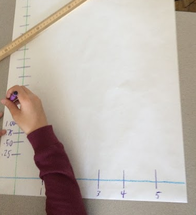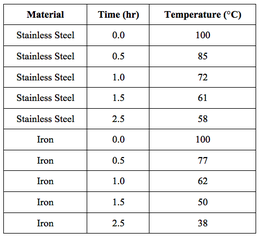Analyzing and Interpreting Data
Goals:
- Engage in analyzing and interpreting data
- Define and give examples of what it means for students to engage in the science practice of analyzing and interpreting data
- Examine a progression of this science practice for student performance
- Assess the use of this science practice in current classroom instruction
Agenda:
|
Materials: |
1. Defining Analyzing and Interpreting Data
|
Think-pair-share:
The Instructional Leadership for Science Practices Website defines this practice as students:
making sense of the data produced during investigations. Because patterns are not always obvious, this includes using a range of tools such as tables, graphs and other visualization techniques. |
2. Thermal Energy Activity
Target standards:
- Determine the relationships among the energy transferred, how well the type of matter retains or radiates heat, the mass, and the change in the average kinetic energy of the particles as measured by the temperature of the sample. [MS-PS3-4]
- Explain how heat energy is transferred by convection, conduction, and radiation. [Introductory Physics Standard 3.1]
Discussion Questions:
- How did you analyze and interpret data during the activity? What types of things did you do?
- Re-examine questions "a" through "e" on the activity handout. Which of these question(s) do you think focus most on “analyzing and interpreting data” ? Why do you think so?
3. Video Example and Discussion
Watch the video below called "Average Drop Speed", which focuses on a classroom engaged in an activity around the question - Why do some parachutes fall more slowly than others?
Discussion Questions:
- What did the teacher do to promote this science practice?
- What did the students do that highlights or builds on skills related to this science practice?
4. Continuum for Student Performance
Examine the progression below, and discuss the following questions:
- Do you agree with the progression? Why or why not?
- What are examples of what these different levels might look like in the classroom?
- How would you rate your students’ current engagement in this science practice using this progression?
Level 1 Level 2 Level 3 Level 4
5. Reflecting on Instructional Strategies
|
Read through the Instructional Strategies handout. Select one strategy that you have tried, or would like to try, in your classroom. In small groups, discuss the following questions:
|
|
*Extension Activity - Connection to Other Science Practices
The Task:
- Look through the list of science practices below. Brainstorm, and then share out, ways that "analyzing and interpreting data" connects with the other science practices.
|
Investigating Practices
|
Sensemaking Practices
|
Critiquing Practices
|
|
|
|
|
|
|
|
Additional Resources
If you want to learn more about "analyzing and interpreting data" check out:
© 2016 Boston Public Schools Science Department




